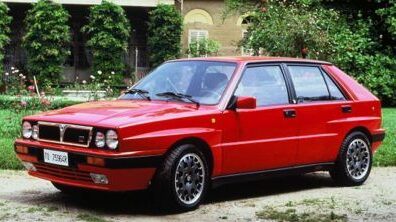‘BACK TO THE FUTURE’ CLASSICS OF THE LAST 30 YEARS
Kim Henson extolls the virtues of another ‘modern classic’ from the three decades that have passed under our wheels since the Western Group of Motoring Writers was born. In my series of 12 features entitled ‘Back to the Future Classics’, and appearing on our Western Group’s website throughout 2013, I am writing about a variety of different models, all held in high regard when they were first introduced, and since. This is my own selection, and while it cannot hope to include all worthy contenders, nevertheless it is intended to represent “12 of the most significant future classics launched in that time”.
This story starts a few years before the advent of the Western Group.
In fact it was in 1979, at the Frankfurt Motor Show, that the attractive, yet unobtrusive, Giugiaro-styled Lancia Delta hatchback made its debut. It was widely thought to be a competent family car, but the newcomer also had great potential for being uprated. By 1982 the four wheel drive Audi Quattro had already made a huge impact in rallying, and Lancia was keen to compete against this all-conquering machine.
The Italian company’s intentions were underlined at the 1982 Turin Motor Show, when a four wheel drive version of the Delta was unveiled.
The Delta 4×4 was featured a 130 bhp, turbocharged 1.6 litre engine, linked to a permanent four wheel drive system. In 1983 the model was redesignated HF Turbo, and was productionised with a front wheel drive set-up.
The Delta S4 4×4 arrived in 1985, with 250 bhp produced by its 16 valve, 1.8 litre engine (in ‘road-going’ form). An even more spectacular 400 bhp version of the S4 won the 1986 World Rally Championship.
In 1986 a new, 140 bhp HF Turbo i.e. made its public debut (with Weber fuel injection), and the fuel-injected, turbocharged two litre, 165 bhp HF 4WD (with a Thema-derived power unit, and featuring integrated electronic management of the ignition and fuel-injection systems) was also introduced, at the Turin Motor Show.

The drivetrain of this model was re-engineered, compared with that of previous four wheel drive Deltas, and incorporated a centre differential/Ferguson viscous coupling, plus a torque-sensing (‘Torsen’) rear differential.
Visual identifiers of this formidable machine included quadruple headlamps, bonnet vents and side skirts (plus interior enhancements)
Changes in world rallying regulations saw the rapid development of a new, redesigned version of the model, producing 260 bhp. The results were worth the effort, with Lancia dominating the honours in the 1987 season.
Enthusiasts were impressed by the 185 bhp, eight valve HF Integrale, displayed at the 1987 Frankfurt Motor Show. With a restyled front bumper and wide wheel arches it looked purposeful. Changes under the handsome skin included a new turbocharger, plus transmission and running gear upgrades.
During the next two years Lancia continued to clock up victories in rallying, and work was proceeding on the next production version. This emerged at the 1989 Geneva Show in the form of a new 16 valve Integrale.

The 200 bhp newcomer featured a 16 valve cylinder head, a new turbocharger (with an electronically operated wastegate) and intercooler, revised manifolds, modified suspension, anti-lock brakes, also larger section wheels and tyres. Examples sold in Switzerland were fitted with an eight valve engine (to meet local emission regulations).
Rally car versions delivered just under 300 bhp (keeping within the FIA limit of the time), and continued to dominate world rallying.
In 1991 the car evolved again for road use, into the 210 bhp ‘Evoluzione’ (officially titled ‘Delta HF Integrale’). Changes included wider track dimensions, bolder arches covering new wheels, a bonnet bulge, a rear spoiler, new lamps and revised side skirts, plus interior amendments. The steering, suspension and brakes were also upgraded.
Lancia’s association with rallying came to an end in the early 1990s, but the road cars were still produced, with Maggiora building them at Lancia’s Chivasso factory. Developed by Maggiora, the final version (commonly known as the ‘Evo 2’, although never badged thus) was introduced in 1993. The car featured a new, water-cooled turbocharger, a catalytic converter, revised engine settings, standard-fit air conditioning (but lacking a sun roof), 16 inch wheels and high-backed Recaro seats. The power output was now 215 bhp.
Sadly for motoring enthusiasts the Delta HF Integrale (as it was still officially known) was discontinued late in 1994.

During the production years, a number of special editions had been produced, including the 1988 1.6 litre HF ‘Martini’ version sold in Britain
REALITY…
The thrill of the drive is what these cars are about. Particularly rapid acceleration, effortless high speed cruising, impressive traction and pin-sharp handling (which encourages drivers to take to twisting ‘B’ roads!) needs to be experienced to be fully appreciated, or even believed for a car of the 1980s. The ‘Evo’ versions are generally considered to be the most enjoyable of the bunch to drive.
For the record, the zero to 60 mph acceleration time for a 4WD HF is approximately 7.5 seconds, whereas an eight valve HF Integrale will get there a second more rapidly, while HF Integrale 16 valve and ‘Evo’ versions take just 5.5seconds to reach this speed.
Ultimately the 16 valve versions will reach speeds in excess of 135 mph.
The ride quality is definitely ‘firm’ – although the accommodating seats compensate to an extent.
By contrast with many classic hot hatchbacks, the interior and boot are reasonably spacious, and the five door body shell makes the model more user-friendly than many, in terms of everyday practicality.
Fuel consumption is not as bad as might be imagined; in fact up to 35 mpg can be obtained when cruising gently. By contrast, when making the most of the available performance, typical mpg figures in the low twenties can be expected.

VERDICT
Many believe that Delta Integrales are the most memorable – and most important –Lancias ever produced.Today the cars are still revered for the sheer exhilaration provided by their extraordinary dynamic performance. Interest in these fascinating models is increasing, as are asking prices.
Images courtesy of Virtual Motorpix – © Kim Henson

